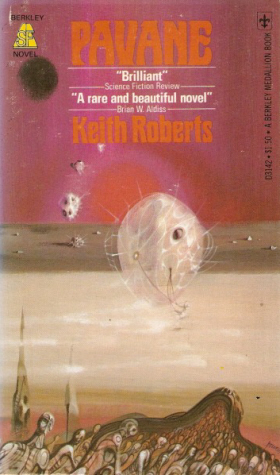Vintage Treasures: Pavane by Keith Roberts
 |
 |
 |
I think I first took notice of Keith Roberts’s classic alternate history Pavane because it was part of the famed Ace Science Fiction Special line. The Ace specials, edited by Terry Carr, were a legendary line of (mostly) original paperbacks that included some of the most acclaimed SF and fantasy ever published, such as R. A. Lafferty’s Past Master (1968), Ursula K. Le Guin’s The Left Hand of Darkness (1969), Alexei Panshin’s Rite of Passage (1969), John Brunner’s The Traveler in Black (1971), and William Gibson’s Neuromancer (1984). Pavane was one of the rare reprints; it first appeared in hardcover in 1968, and the Ace paperback came along a year later, with a cover by Leo Dillon and Diane Dillon (above left).
Pavane has been reprinted many, many times in the past four decades — at least 20 times, by my count. Frankly, I’d be surprised if it’s been out of print for more than a year or two over the past forty years. Trust me, that’s evidence of an exceptional book, with the kind of appeal that crosses generations. Berkley put a very purple Richard Powers on their 1976 paperback edition (above, middle), but I think my favorite cover may be Chuck Minichiello’s, for the 1982 Ace reprint (right).
What’s Pavane all about, then? It’s a collection of nine linked short stories, most of them published in the British SF magazine Impulse in 1966. Roberts imagines a complex and well-realized alternate world where England fell to the Spanish Armada in the 16th Century, and the 20th Century sees the all-powerful hegemony of the Church of Rome, which has ruthlessly smothered scientific progress through the terror of the Inquisition. But knowledge cannot be suppressed indefinitely and the world is beginning to inexorably change…
Here’s the plot summary from the inside cover of my 1969 edition:
In the year 1588, Queen Elizabeth of England was assassinated. As a result, when the Spanish Armada attacked, England went down defeated, changing the history of Europe and the New World as we know it.
Now, in the Twentieth Century, the Church of Rome reigns supreme over a world of pastoral beauty, while technology is held back to the level of the steam locomotive and the primitive radio. Yet science cannot be suppressed forever, and its advocates are becoming more daring as each year passes. A revolution is building — one that will rock the foundations of an empire. An acknowledged classic of alternate history fiction, Pavane will continue to inspire writers and readers for generations…
Pavane has returned to print recently as well. It is #35 in the Millennium SF Masterworks series, for example. Here’s some of the more modern editions.
 |
 |
 |
On the left is Penguin’s 1984 edition, with a gorgeous and eye-catching cover by David O’Connor. In the middle is the SF Masterworks version from Millennium / Gollancz (2000; cover by Jim Burns), and on the right is the Del Ray trade paperback (2001, cover by Richard A. Cooke III and George Gower).
As I’ve mentioned before, a parade of side-by-side book covers will often tell you as much about the eras the book was published as the book itself. I don’t think the progression here follows as clear a path as, say, the changing women portrayed on the cover of Fritz Leiber’s Conjure Wife, but it’s still interesting to see the similarities in the way Pavane‘s core concepts are displayed through the years. Notice the priests giving a benediction on the 1968 and 1982 Ace editions, for example, or the steam engine on the cover of all three later editions.
If you’re a paperback collector, you obviously have a nice assortment of options if you wish to acquire a copy. I recommend getting them all, of course, but more prudent collectors might go for any of the early Ace editions, or the Berkley paperback, all of which are relatively easy to find. Expect to spend under $10 for a copy in good condition.
The SF Masterworks edition is perhaps the most collectible of the later versions. Old Earth Books re-released Pavane in a handsome trade paperback with the original Leo and Diane Dillon cover in December 2011; that edition is still in print, priced at $17. It’s also available in digital format from Hachette for $6.99 (if you can convince Amazon to sell you a Hachette book).
See all of our recent Vintage Treasures here, and Matthew David Surridge’s detailed review of Pavane here.
I haven’t reread this one in years. I remember really liking it as well as his post-apocalyptic stories in The Chalk Giants and the collection Passing of the Dragons. I wonder how well they hold up.
I’ve never read either, although I’ve been sorely tempted by both — especially THE CHALK GIANTS. Might make a good future VINTAGE TREASURES post… unless you beat me to it!
I picked up a copy of the Old Earth Books edition a couple of years ago, on the basis of a BG essay. One of Surridge’s, maybe? It’s about midway down my TBR pile.
[…] Vintage Treasures: Pavane by Keith Roberts Classic Alternatives: Keith Roberts’ Pavane, by Matthew David Surridge […]